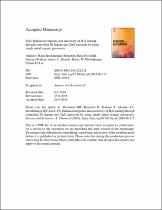 ResearchSpace
ResearchSpace
Enhanced response and selectivity of H2S sensing through controlled Ni doping into ZnO nanorods by using single metal organic precursors
JavaScript is disabled for your browser. Some features of this site may not work without it.
- ResearchSpace
- →
- Research Publications/Outputs
- →
- Journal Articles
- →
- View Item
| dc.contributor.author |
Modaberi, MR

|
|
| dc.contributor.author |
Rooydell, R

|
|
| dc.contributor.author |
Brahma, S

|
|
| dc.contributor.author |
Akande, Amos A

|
|
| dc.contributor.author |
Mwakikunga, Bonex W

|
|
| dc.contributor.author |
Liu, C-P

|
|
| dc.date.accessioned | 2019-03-22T11:43:51Z | |
| dc.date.available | 2019-03-22T11:43:51Z | |
| dc.date.issued | 2018-11 | |
| dc.identifier.citation | Modaberi, M.R. et al. 2018. Enhanced response and selectivity of H2S sensing through controlled Ni doping into ZnO nanorods by using single metal organic precursors. Sensors and Actuators B: Chemical, vol. 273: 1278-1290 | en_US |
| dc.identifier.issn | 0925-4005 | |
| dc.identifier.uri | https://doi.org/10.1016/j.snb.2018.06.117 | |
| dc.identifier.uri | https://www.sciencedirect.com/science/article/pii/S092540051831222X | |
| dc.identifier.uri | http://hdl.handle.net/10204/10828 | |
| dc.description | Copyright: 2018 Elsevier. Due to copyright restrictions, the attached PDF file contains the accepted version of the published item. For access to the published version, please consult the publisher's website. | en_US |
| dc.description.abstract | We report on enhancing the selectivity and response of room (23 °C) and high temperature H2S gas sensing through controlled Ni doping (0–10 at%) into ZnO nanorods (NRs) grown with a facile solution growth method using a single hybrid bimetallic metal-organic precursor (nickel/zinc acetylacetonate). The morphology, microstructure, surface chemistry and photoluminescence properties of the as-grown NRs are extensively examined. The gas sensing results are discussed in terms of doping concentration, operating temperature, gas type, gas concentrations and relative humidity. The optimal response toward 100 ppm of H2S reaches 3.1 at 23 °C and increases to 45.3 at 200 °C for 8 at% Ni-doped ZnO NR sensors, where the corresponding response/recovery time at 23 °C and 200 °C also reaches 76/160 and 48/60 s, respectively. The same sensor exhibits high H2S selectivity over other gases, including CH4, CH3OH and C2H5OH. The enhancement of gas sensing is attributed to increasing the number of active sites for adsorption of oxygen and target gases on the surface through incorporation of Ni3+ over Ni2+ ions. At 23 °C, the sensing mechanism is related to the formation of a 7 nm-thick ZnS layer over the NRs through reactions between H2S and adsorbed oxygen. | en_US |
| dc.language.iso | en | en_US |
| dc.publisher | Elsevier | en_US |
| dc.relation.ispartofseries | Worklist;21369 | |
| dc.subject | ZnO nanorod | en_US |
| dc.subject | ZnS layer | en_US |
| dc.subject | Metal-organic precursor | en_US |
| dc.subject | H2S sensor | en_US |
| dc.title | Enhanced response and selectivity of H2S sensing through controlled Ni doping into ZnO nanorods by using single metal organic precursors | en_US |
| dc.type | Article | en_US |
| dc.identifier.apacitation | Modaberi, M., Rooydell, R., Brahma, S., Akande, A. A., Mwakikunga, B. W., & Liu, C. (2018). Enhanced response and selectivity of H2S sensing through controlled Ni doping into ZnO nanorods by using single metal organic precursors. http://hdl.handle.net/10204/10828 | en_ZA |
| dc.identifier.chicagocitation | Modaberi, MR, R Rooydell, S Brahma, Amos A Akande, Bonex W Mwakikunga, and C-P Liu "Enhanced response and selectivity of H2S sensing through controlled Ni doping into ZnO nanorods by using single metal organic precursors." (2018) http://hdl.handle.net/10204/10828 | en_ZA |
| dc.identifier.vancouvercitation | Modaberi M, Rooydell R, Brahma S, Akande AA, Mwakikunga BW, Liu C. Enhanced response and selectivity of H2S sensing through controlled Ni doping into ZnO nanorods by using single metal organic precursors. 2018; http://hdl.handle.net/10204/10828. | en_ZA |
| dc.identifier.ris | TY - Article AU - Modaberi, MR AU - Rooydell, R AU - Brahma, S AU - Akande, Amos A AU - Mwakikunga, Bonex W AU - Liu, C-P AB - We report on enhancing the selectivity and response of room (23 °C) and high temperature H2S gas sensing through controlled Ni doping (0–10 at%) into ZnO nanorods (NRs) grown with a facile solution growth method using a single hybrid bimetallic metal-organic precursor (nickel/zinc acetylacetonate). The morphology, microstructure, surface chemistry and photoluminescence properties of the as-grown NRs are extensively examined. The gas sensing results are discussed in terms of doping concentration, operating temperature, gas type, gas concentrations and relative humidity. The optimal response toward 100 ppm of H2S reaches 3.1 at 23 °C and increases to 45.3 at 200 °C for 8 at% Ni-doped ZnO NR sensors, where the corresponding response/recovery time at 23 °C and 200 °C also reaches 76/160 and 48/60 s, respectively. The same sensor exhibits high H2S selectivity over other gases, including CH4, CH3OH and C2H5OH. The enhancement of gas sensing is attributed to increasing the number of active sites for adsorption of oxygen and target gases on the surface through incorporation of Ni3+ over Ni2+ ions. At 23 °C, the sensing mechanism is related to the formation of a 7 nm-thick ZnS layer over the NRs through reactions between H2S and adsorbed oxygen. DA - 2018-11 DB - ResearchSpace DP - CSIR KW - ZnO nanorod KW - ZnS layer KW - Metal-organic precursor KW - H2S sensor LK - https://researchspace.csir.co.za PY - 2018 SM - 0925-4005 T1 - Enhanced response and selectivity of H2S sensing through controlled Ni doping into ZnO nanorods by using single metal organic precursors TI - Enhanced response and selectivity of H2S sensing through controlled Ni doping into ZnO nanorods by using single metal organic precursors UR - http://hdl.handle.net/10204/10828 ER - | en_ZA |





